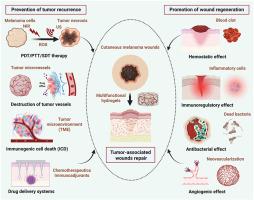多功能水凝胶协同治疗皮肤黑色素瘤相关肿瘤复发和伤口再生
IF 10.2
1区 医学
Q1 ENGINEERING, BIOMEDICAL
引用次数: 0
摘要
皮肤黑色素瘤是一种起源于黑色素细胞的高度侵袭性恶性肿瘤,其术后复发和转移风险严重威胁患者的生存。传统的手术切除、放化疗等治疗方法只能在短期内控制病情,面临肿瘤微环境免疫抑制(tumor microenvironments, TME)、耐药和全身毒性等严重的局限性。局部复发、伤口感染和愈合缓慢是黑色素瘤术后常见的挑战。近年来,基于多功能水凝胶的协同治疗策略因其独特的生物材料特性,如高生物相容性、可编程药物释放和支持组织再生而成为研究的前沿。在不同的肿瘤治疗应用场景中,利用不同类型的配合物合成多功能水凝胶,并介绍了各种新的制备工艺和强大的功能成分。水凝胶能够实现反应触发的精准给药,在免疫治疗、放疗和光治疗中形成协同系统,逆转抑制TME,通过多种信号通路发挥强大的抗肿瘤作用。此外,其改善的亲水性和仿生微细胞结构可以加速术后创面再生,抗菌成分的联合使用可以有效防止局部免疫微环境干扰导致的术后创面感染。本文从水凝胶的功能化设计、抗肿瘤分子机制、免疫微环境调控、抗菌效果、创面再生协同策略等方面,系统综述和总结了水凝胶治疗皮肤黑色素瘤的前沿研究进展,以期为今后肿瘤相关创面组织工程材料的临床转化提供理论依据和技术参考。本文章由计算机程序翻译,如有差异,请以英文原文为准。

Multifunctional hydrogels for synergistic therapy of cutaneous melanoma-associated tumor recurrence and wound regeneration
Cutaneous melanoma is a highly aggressive malignant tumor originated from melanocytes, and its postoperative recurrence and metastatic risk seriously threaten patient survival. Traditional treatments like surgical resection and chemoradiotherapy can merely control the disease in the short term, which faces severe limitations such as immunosuppression of tumor microenvironments (TME), drug resistance and systemic toxicity. Local recurrence, wound infection, and slow healing are common challenges in melanoma post-operation. In recent years, synergistic therapeutic strategies based on multifunctional hydrogels have been at the forefront of research due to their exceptional biomaterial properties, such as high biocompatibility, programmable drug release and tissue regeneration support. Different types of complexes are utilized to synthesize multifunctional hydrogels in different oncology therapeutic application scenarios, and various novel preparation processes and powerful functional components are introduced. Hydrogels have the ability to achieve responsive-triggered precision drug delivery, forming a synergistic system in immunotherapy, radiotherapy and phototherapy, reverse the inhibitory TME, and exert powerful anti-tumor effects through multiple signaling pathways. In addition, its improved hydrophilicity and biomimetic microcellular structure could accelerate postoperative wound regeneration, and the combination of antimicrobial components can effectively prevent postoperative wound infections resulting from disturbed local immune microenvironment. In this paper, we systematically reviewed and summarized the cutting-edge advances of hydrogels used for treating cutaneous melanoma, focusing on their functionalized design, anti-tumor molecular mechanisms, immune microenvironment regulation, antibacterial efficacy and synergistic strategies of wound regeneration, with a view to providing theoretical basis and technical references for future clinical translation of tissue engineering materials for tumor-associated wounds.
求助全文
通过发布文献求助,成功后即可免费获取论文全文。
去求助
来源期刊

Materials Today Bio
Multiple-
CiteScore
8.30
自引率
4.90%
发文量
303
审稿时长
30 days
期刊介绍:
Materials Today Bio is a multidisciplinary journal that specializes in the intersection between biology and materials science, chemistry, physics, engineering, and medicine. It covers various aspects such as the design and assembly of new structures, their interaction with biological systems, functionalization, bioimaging, therapies, and diagnostics in healthcare. The journal aims to showcase the most significant advancements and discoveries in this field. As part of the Materials Today family, Materials Today Bio provides rigorous peer review, quick decision-making, and high visibility for authors. It is indexed in Scopus, PubMed Central, Emerging Sources, Citation Index (ESCI), and Directory of Open Access Journals (DOAJ).
 求助内容:
求助内容: 应助结果提醒方式:
应助结果提醒方式:


